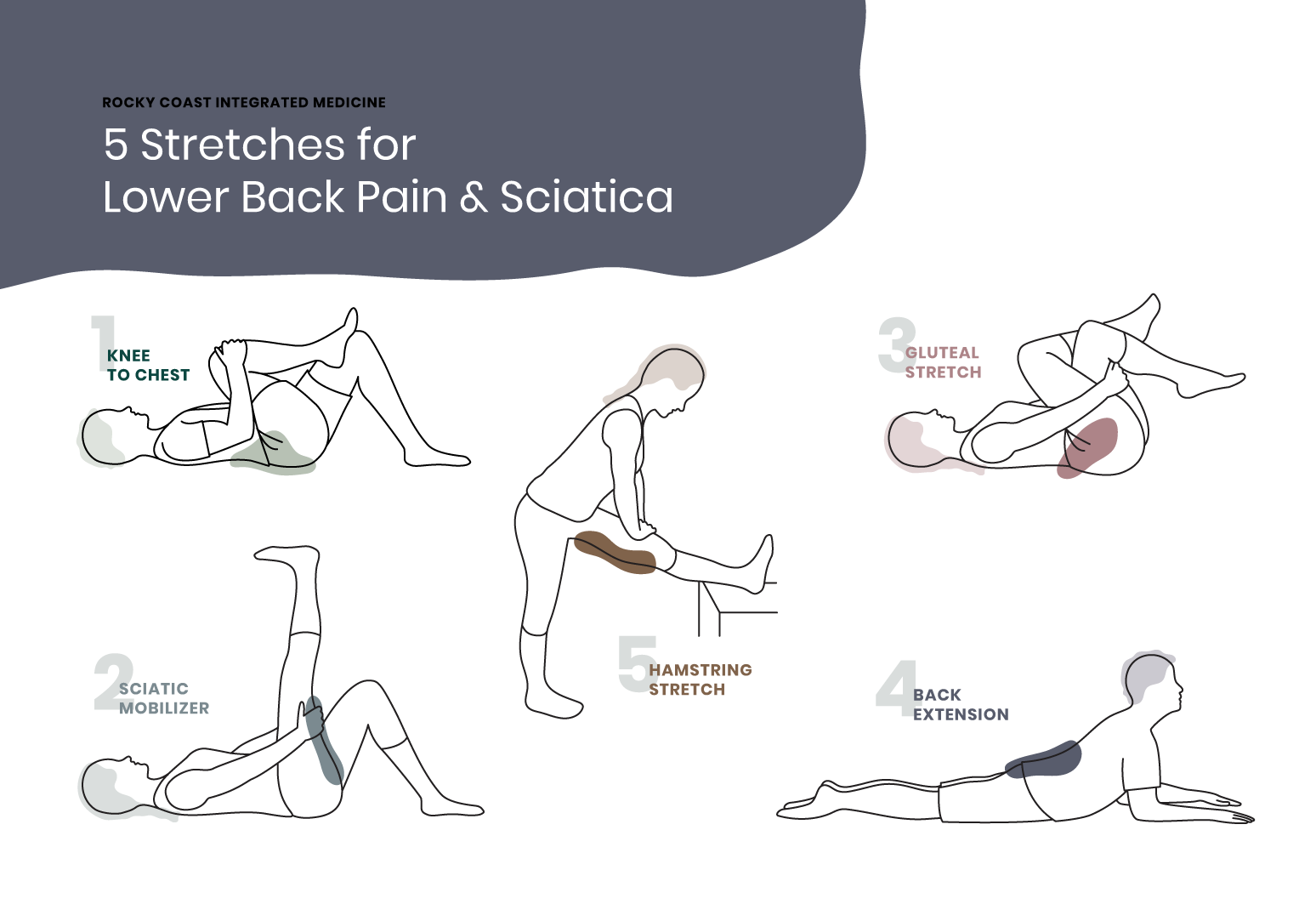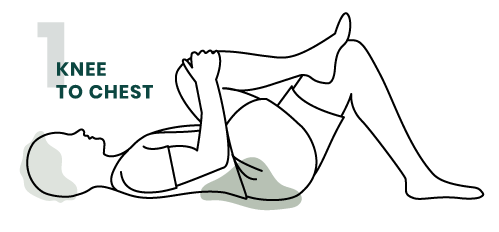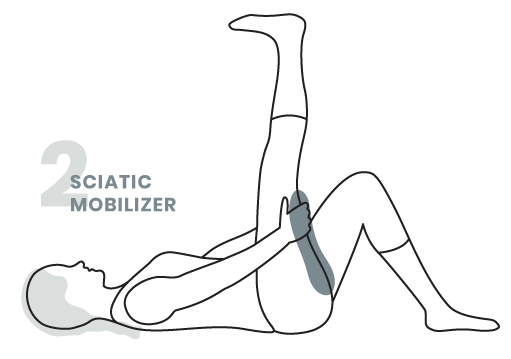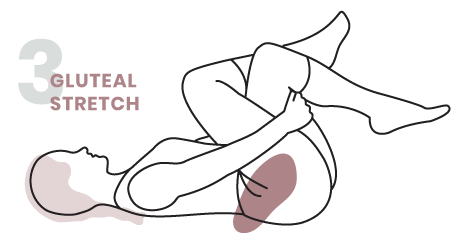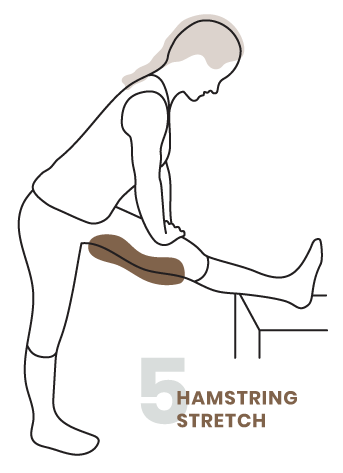Stretches & Exercises for Lower Back Pain and Sciatica
Lower back pain and sciatica are two problems we see regularly at Rocky Coast Integrated Medicine in Portland, Maine. These common conditions can be extremely uncomfortable and have a serious impact on your ability to carry out even simple tasks.
Although acupuncture can speed up the healing process and offer some much-needed pain relief, clients should also practice sciatica exercises and stretches at home between appointments. Regular exercise can help to improve strength and flexibility, and is one of the most important forms of sciatica pain management.
In this article, we will look at what causes sciatica to flare up, some of the best stretches for lower back pain and sciatica, and how to do them safely at home.
What Causes Sciatica to Flare Up?
Sciatica flares up when the sciatic nerve is irritated in some way. The sciatic nerve runs from the lower back to the toes, which is why sciatica can cause tingling or numbness in the legs and feet as well as lower back pain.
Sciatica is usually a result of excess pressure on the sciatic nerve due to a back problem such as a prolapsed disc, spinal stenosis, spondylolisthesis, or a back injury.
Exercise for Sciatica Pain Management
If you have sciatica, it is essential that you stay mobile and participate in some gentle exercise every day. Some of the best sciatica exercises include walking, swimming, and yoga. There are also a number of specific stretches for lower back pain and sciatica which can really help when done on a daily basis.
In order for your sciatica exercises to be effective, it is important to do them correctly. Exercising with poor technique could mean that your symptoms will not get any better. In some cases, they might even become worse.
Therefore, it is a good idea to have your technique checked by a physical therapist or other qualified professional before doing sciatica exercises for the first time.
Enhancing Your Recovery with Proper Nutritional Support
While exercise and stretching are fundamental to managing sciatic pain, proper nutritional support can play a valuable role in your recovery process. Certain nutrients can help support nerve health and maintain a healthy inflammatory response in the body. To make it easier for our patients to access high-quality supplements that complement their exercise routine, we've carefully curated a supplement bundle through Fullscript that targets nerve health and comfort. Of course, always consult with your healthcare provider before starting any new supplement regimen.
This targeted bundle combines three key supplements - EPA/DHA for nerve health, Curcumin for inflammation response, and R-Lipoic Acid for nerve function - working together to provide comprehensive support for those experiencing sciatic discomfort.
EPA/DHA Essentials (Omega-3s) These essential fatty acids help maintain a healthy inflammatory response in the body and support nerve health. EPA and DHA are particularly beneficial for nerve tissue health and can help reduce inflammation around the sciatic nerve. These omega-3s also support overall joint and muscle function.
Curcumin The active compound in turmeric, curcumin is renowned for its ability to support a healthy inflammatory response in the body. For sciatic pain, curcumin helps maintain comfort and mobility by supporting the body's natural inflammatory processes. It also provides antioxidant properties that support overall nerve and tissue health.
R-Lipoic Acid This powerful antioxidant specifically supports nerve health and function. R-Lipoic Acid helps protect nerve tissue and supports healthy nerve signaling. It's particularly beneficial for maintaining nerve comfort and has been studied for its role in supporting healthy nerve function throughout the body.
The Best Stretches for Lower Back Pain and Sciatica
There are a number of lower back pain and sciatica exercises which you can try safely at home. Remember to take it slowly at first, and gradually build up to doing more as you feel more comfortable.
If at any point during these exercises you experience increased pain, stop immediately and contact your physical therapist or healthcare provider.
Knee to Chest
This is one of the best stretches for the lower back and is an important exercise for sciatica pain management.
● Lie down with your knees bent and feet flat on the floor, approximately hip width apart
● Raise your head slightly using a book, yoga block, or flat cushion
● Relax your shoulders and tuck your chin in to your chest
● Slowly pull one knee up toward your chest
● Hold for 20–30 seconds
● Slowly return your foot to the floor and repeat with the opposite leg
● Repeat 2–3 times on each side
2. Sciatic Mobilizer
Another great sciatica exercise, this stretch benefits the hamstrings and keeps the legs flexible.
● Lie down with your knees bent and feet flat, around hip width apart
● Raise your head using a book, yoga block, or flat cushion
● Relax your shoulders and tuck your chin in to your chest
● Slowly pull one knee up toward your chest
● Hold onto the back of your thigh and slowly straighten your leg
● Hold for 20–30 seconds
● Slowly return your foot to its original position and repeat with the opposite leg
● Repeat 2–3 times on each side
3. Gluteal stretch
This deep stretch can be felt in the backs of the thighs and gluteal muscles (buttocks). These two areas are frequently affected by sciatica pain.
● Lie on the floor with your knees bent, feet flat and hip width apart
● Raise your head using a book, yoga block, or flat cushion
● Relax your shoulders and tuck in your chin
● Slowly pull your left knee up and rest your ankle on your right thigh
● Loop your hands around your right thigh and pull the leg up toward your chest
● Keep your lower back on the floor and your hips straight
● Hold for 20–30 seconds
● Slowly release and repeat with the opposite leg
● Repeat 2–3 times on each side
4. Back Extension
This is a great stretch for lower back pain and may be especially helpful if your symptoms are caused by a prolapsed disc.
● Lie on your stomach with your forearms on the floor, elbows bent and tucked in to your sides
● Keep your neck straight and your lower body relaxed
● Keeping your forearms on the floor, slowly push up and arch your back gently
● Hold for 5–10 seconds then relax
● Repeat 8–10 times
5. Hamstring Stretch
Another important exercise to keep the hamstrings flexible. Ensure that you do this exercise on a stable surface and if necessary, hold onto something to help you balance.
● In a standing position, raise one foot up on a solid surface such as a step or bench
● Point your toes upward and keep your leg straight
● Slowly lean forward, keeping your back straight
● Hold for 20–30 seconds
● Return your foot to the floor and repeat with the opposite leg
● Repeat 2–3 times on each side
When to do Your Sciatica Exercises
For the best results, you should do these stretches several times a day. Although it can be time consuming, this is the best way to ensure that your sciatica exercises are effective and is definitely worth the effort.
You should also keep your body moving between doing these exercises and aim to do at least 30 minutes of walking or other gentle physical activity each day. Avoid sitting or lying for long periods as this can make sciatica symptoms worse.
For more information, talk to your healthcare provider.
Integrating Supplements with Your Sciatic Care Routine
While stretching and movement are essential for managing sciatic nerve pain, targeted nutritional support may help complement your recovery process. We've curated a specialized supplement bundle through Fullscript that includes natural anti-inflammatory ingredients and nerve-supporting nutrients. This carefully selected combination of supplements works alongside your stretching routine to help reduce discomfort and support overall nerve health. Click here to access our recommended supplement protocol for sciatic pain management.

